Self-Expressive Creativity in the Adolescent Digital Domain: Personality, Self-Esteem, and Emotions
Abstract
1. Introduction
1.1. Self-Expressive Creativity in the Digital Domain and Personality
1.2. Self-Expressive Creativity in the Digital Domain, Self-Esteem, and Emotions
2. Materials and Methods
2.1. Participants
2.2. Instruments
2.2.1. Self-Expressive Creativity
2.2.2. Big Five Inventory
2.2.3. Rosenberg Self Esteem Scale (RSE)
2.2.4. Expression, Management, and Emotion Recognition Evaluation Scale (TMMS-24)
2.3. Procedure
2.4. Data Analysis
3. Results
3.1. Adolescent Self-Expressive Creativity, EI, Self-Esteem, and Personality: Descriptive and Correlational Analyses
3.2. Mediation Models for Self-Esteem and EI on the Relationship of Personality and Self-Expressive Creativity
4. Discussion
4.1. Limitations
4.2. Implications
5. Conclusions
Author Contributions
Funding
Acknowledgments
Conflicts of Interest
References
- Smith, P.K.; Mahdavi, J.; Carvalho, M.; Fisher, S.; Russell, S.; Tippett, N. Cyberbullying: Its nature and impact in secondary school pupils. J. Child Psychol. Psiquiatr. 2008, 49, 376–385. [Google Scholar] [CrossRef]
- Lee, Y.C.; Wu, W.-L. Factors in cyber bullying: The attitude-social influence-efficacy model. Ann. Psicol. 2018, 34, 324–331. [Google Scholar] [CrossRef]
- Van Goethem, A.A.; Scholte, R.H.; Wiers, R.W. Explicit and implicit bullying attitudes in relation to bullying behavior. J. Abnorm. Child Psychol. 2010, 38, 829–842. [Google Scholar] [CrossRef]
- Avilés, J.M.; Petta, R. The Peer Support Systems for the promotion of convivencia, the improvement of the classroom climate and the prevention of situations of bullying: The experience of Brazil and Spain. Eur. J. Dev. Educ. Psychop. 2018, 1, 5–17. [Google Scholar] [CrossRef]
- Carbonell, N.; Cerezo, F. El programa cie: Intervención en ciberacoso escolar mediante el desarrollo de la inteligencia emocional [CIE program: Intervention in cyberbullying by de development of the Emotional Intelligence]. Eur. J. Health. Res. 2019, 5, 39–49. [Google Scholar] [CrossRef]
- Beltrán-Catalán, M.; Zych, I.; Ortega-Ruiz, R.; Llorent, V.J. Victimisation through bullying and cyberbullying: Emotional intelligence, severity of victimisation and technology use in different types of victims. Psicothema 2018, 30, 183–188. [Google Scholar] [CrossRef] [PubMed]
- Gázquez, J.J.; Pérez-Fuentes, M.C.; Carrión, J.J.; Santiuste, V. Estudio y análisis de conductas violentas en Educación Secundaria en España [Study and analysis of violent behaviour in Secondary Education in Spain]. Univ. Psychol. 2010, 9, 371–380. [Google Scholar] [CrossRef]
- Muros, B.; Aragón, Y.; Bustos, A. La ocupación del tiempo libre de jóvenes en el uso de videojuegos y redes [Youth’s usage of leisure time with video games and social networks]. Comunicar 2013, 40, 31–39. [Google Scholar] [CrossRef]
- Cheung, C.M.; Chiu, P.Y.; Lee, M.K. Online social networks: Why do students use facebook? Comput. Hum. Behav. 2011, 27, 1337–1343. [Google Scholar] [CrossRef]
- Guilford, J.P. Creativity. Am. Psychol. 1950, 5, 444–454. [Google Scholar] [CrossRef]
- Torrance, E. The nature of creativity as manifest in its testing. In The Nature of Creativity: Contemporary Psychological Perspectives; Sterrnberg, R.J., Ed.; Cambridge University Press: New York, NY, USA, 1988; pp. 99–121. [Google Scholar]
- Amabile, T.M. The social psycholoy of creativity: A componential conceptualization. J. Personal. Soc. Psychol. 1983, 45, 357–376. [Google Scholar] [CrossRef]
- Csikszentmihalyi, M. Creativity. Flow and the Psychology of Discovery and Invention; HarperCollins Publishers: New York, NY, USA, 1996. [Google Scholar]
- Sternberg, R.J.; Lubart, T.I. Invest in creativity. Am. Psychol. 1996, 51, 677–688. [Google Scholar] [CrossRef]
- De Bono, E. Serious Creativity: Using the Power of Lateral Thinking to Create New Ideas; Harper Collins: New York, NY, USA, 1992. [Google Scholar]
- Amabile, T.M. Motivation and creativity: Effects of motivational orientation creative writers. J. Personal. Soc. Psychol. 1985, 48, 393–399. [Google Scholar] [CrossRef]
- Gardner, H. Creating Minds; Basic Books: New York, NY, USA, 1993. [Google Scholar] [CrossRef]
- Richards, R.; Kinney, D.K.; Benet, M.; Merzel, A.P.C. Assessing everyday creativity: Characteristics of the Everyday Creativity Scales and validation with three large samples. J. Personal. Soc. Psychol. 1988, 54, 467–485. [Google Scholar] [CrossRef]
- Runco, M.A. Everyone has creative potential. In Creativity: From Potential to Realization; Sternberg, R.J., Grigorenko, E.L., Singer, J.L., Eds.; American Psychological Association: Washington, DC, USA, 2004; pp. 21–30. [Google Scholar]
- Ivcevic, Z. Artistic and everyday creativity: An act-frequency approach. J. Creat. Behav. 2007, 41, 271–290. [Google Scholar] [CrossRef]
- Silvia, P.J.; Beaty, R.E.; Nusbaum, E.C.; Eddington, K.M.; Levin-Aspenson, H.; Kwapil, T.R. Everyday creativity in daily life: An experience-sampling study of “little c” creativity. Psychol. Aesthet. Creat. Arts 2014, 8, 183–188. [Google Scholar] [CrossRef]
- Ivcevic, Z.; Brackett, M.A.; Mayer, J.D. Emotional intelligence and emotional creativity. J. Personal. 2007, 75, 199–236. [Google Scholar] [CrossRef]
- Ivcevic, Z.; Mayer, J.D. Mapping dimensions of creativity in the life-space. Creat. Res. J. 2009, 21, 152–165. [Google Scholar] [CrossRef]
- Hoffmann, J.; Ivcevic, Z.; Brackett, M. Creativity in the age of technology: Measuring the digital creativity of millennials. Creat. Res. J. 2016, 28, 149–153. [Google Scholar] [CrossRef]
- Wechsler, S.M.; Benson, N.; de Lara, W.; Bachert, M.D.A.; Gums, E.F. Adult temperament styles: A network analysis of their relationships with the Big Five Personality Model. Eur. J. Educ. Psychol. 2018, 11, 61–75. [Google Scholar] [CrossRef]
- Oliva, A. Desarrollo cerebral y asunción de riesgos durante la adolescencia [Brain development and risk taking during adolescence]. Apunt. Psicol. 2012, 30, 477–486. [Google Scholar]
- Martínez-Loredo, V.; Fernández-Hermida, J.R.; de La Torre-Luque, A.; Fernández-Artamendi, S. Polydrug use trajectories and differences in impulsivity among adolescents. Int. J. Clin. Health 2018, 18, 235–244. [Google Scholar] [CrossRef] [PubMed]
- Nieto, B.; Portela, I.; López, E.; Domínguez, V. Verbal violence in students of compulsory secondary education. Eur. J. Investig. 2018, 8, 5–14. [Google Scholar] [CrossRef]
- Pérez-Fuentes, M.C.; Molero, M.M.; Barragán, A.B.; Gázquez, J.J. Profiles of violence and alcohol and tobacco use in relation to impulsivity: Sustainable consumption in adolescents. Sustainability 2019, 11, 651. [Google Scholar] [CrossRef]
- Pérez-Fuentes, M.; Gázquez, J.J.; Molero, M.M.; Cardila, F.; Martos, A.; Barragan, A.B.; Garzón, A.; Carrión, J.J.; Mercader, I. Adolescent impulsiveness and use of alcohol and tobacco. Eur. J. Investig. 2015, 5, 371–382. [Google Scholar] [CrossRef]
- Ortega, R.; Elipe, P.; Mora-Merchán, J.A.; Genta, M.L.; Brighi, A.; Guarini, A.; Smith, P.K.; Thompson, F.; Tippett, N. The emotional impact of bullying and cyberbullying on victims: A European cross-national study. Aggress. Behav. 2012, 38, 342–356. [Google Scholar] [CrossRef]
- Alonso-Stuyck, P.; Zacarés, J.J.; Ferreres, A. Emotional separation, autonomy in decision-making, and psychosocial adjustment in adolescence: A proposed typology. J. Child Fam. Stud. 2018, 27, 1373–1383. [Google Scholar] [CrossRef]
- Wang, Y.; Wang, L. Self-construal and creativity: The moderator effect of self-esteem. Personal. Individ. Differ. 2016, 99, 184–189. [Google Scholar] [CrossRef]
- Nori, R.; Signore, S.; Bonifacci, P. Creativity style and achievements: An investigation on the role of emotional competence, individual differences and psychometric intelligence. Front. Psychol. 2018, 9, 1826. [Google Scholar] [CrossRef]
- Erol, R.Y.; Orth, U. Self-esteem development from age 14 to 30 years: A longitudinal study. J. Personal. Soc. Psychol. 2011, 101, 607–619. [Google Scholar] [CrossRef]
- John, O.P.; Donahue, E.M.; Kentle, R.L. The Big Five Inventory-Versions 4a and 54; University of California, Institute of Personality and Social Research: Berkeley, CA, USA, 1991. [Google Scholar]
- Judge, T.A.; Erez, A.; Bono, J.E.; Thoresen, C.J. Are measures of selfesteem, neuroticism, locus of control, and generalized self-efficacy indicators of a common core construct? J. Personal. Soc. Psychol. 2002, 83, 693. [Google Scholar] [CrossRef]
- Robins, R.W.; Hendin, H.M.; Trzesniewski, K.H. Measuring global self-esteem: Construct validation of a single-item measure and the Rosenberg Self-Esteem Scale. Personal. Soc. Psychol. Bull. 2001, 27, 151–161. [Google Scholar] [CrossRef]
- Anderson, C.; John, O.P.; Keltner, D. The personal sense of power. J. Personal. 2012, 80, 313–344. [Google Scholar] [CrossRef] [PubMed]
- Molero, M.M.; Pérez-Fuentes, M.C.; Barragán, A.B.; del Pino, R.M.; Gázquez, J.J. Analysis of the Relationship between Emotional Intelligence, Resilience, and Family Functioning in Adolescents’ Sustainable Use of Alcohol and Tobacco. Sustainability 2019, 11, 2954. [Google Scholar] [CrossRef]
- Prado, V.; Villanueva, L.; Górriz, A.B. Trait emotional intelligence and subjective well-being in adolescents: The moderating role of feelings. Psicothema 2018, 30, 310–315. [Google Scholar] [CrossRef]
- Guastello, S.J.; Guastello, D.D.; Hanson, C.A. Creativity, mood disorders, and emotional intelligence. J. Creat. Behav. 2004, 38, 260–281. [Google Scholar] [CrossRef]
- Mayer, J.D.; Salovey, P.; Caruso, D.R. Emotional intelligence: New ability or eclectic traits? Am. Psychol. 2008, 63, 503–517. [Google Scholar] [CrossRef]
- Salguero, J.M.; Fernandez-Berrocal, P.; Balluerka, N.; Aritzeta, A. Measuring perceived emotional intelligence in the adolescent population: Psychometric properties of the Trait Meta-Mood Scale. Soc. Behav. Personal. 2010, 38, 1197–1209. [Google Scholar] [CrossRef]
- Seligman, M. Positive Psychology: Fundamental assumptions. Psychologist 2003, 16, 126–127. [Google Scholar]
- Seligman, M.; Csikszentmihalyi, M. Positive Psychology: An introduction. Am. Psychol. 2000, 55, 5–14. [Google Scholar] [CrossRef]
- Rosenberg, M. Society and the Adolescent Self-Image; Princeton University Press: Princeton, NJ, USA, 1965. [Google Scholar]
- Fernández-Berrocal, P.; Extremera, N.; Ramos, N. Validity and reliability of the Spanish modified version of the Trait Meta-Mood Scale. Psychol. Rep. 2004, 94, 751–755. [Google Scholar] [CrossRef] [PubMed]
- Salovey, P.; Mayer, J.D.; Goldman, S.L.; Turvey, C.; Palfai, T.P. Emotional attention, clarity and repair: Exploring emotional intelligence using the trait meta-mood scale. In Emotion, Disclousure and Health; Pennebaker, J.W., Ed.; American Psychological Association: Washington, DC, USA, 1995; pp. 125–154. [Google Scholar]
- Kaufman, L.; Rousseeuw, P.J. Finding Groups in Data. An Introduction to Cluster Analysis; John Wiley & Sons: New York, NJ, USA, 1990. [Google Scholar]
- Cohen, J. Statistical Power Analysis for the Behavioral Sciences, 2nd ed.; Erlbaum: Hillsdale, NJ, USA, 2013. [Google Scholar]
- Hayes, A.F. Introduction to Mediation, Moderation, and Conditional Process Analysis: A Regression-Based Approach; The Guilford Press: New York, NY, USA, 2013. [Google Scholar]
- Lorenzo-Seva, U.; Ferrando, O.J. FACTOR: A Computer program to fit the exploratory factor analysis model. Behav. Res. Methods 2006, 38, 88–91. [Google Scholar] [CrossRef] [PubMed]
- Domínguez-Lara, S. Fiabilidad y alfa ordinal [Reliability and ordinal alpha]. Actas Urol. Españolas 2018, 42, 140–141. [Google Scholar] [CrossRef]
- Elosua, P.; Zumbo, B.D. Coeficientes de fiabilidad para escalas de respuesta categórica ordenada [Reliability coefficients for ordinal response scales]. Psicothema 2008, 20, 86–901. [Google Scholar]
- Ventura-León, J.L.; Caycho, T. El coeficiente Omega: Un método alternativo para la estimación de la confiabilidad [The Omega coefficient: An alternative method for estimating reliability]. Rev. Latinoam. Cienc. Soc. Niñez Y Juv. 2017, 15, 625–627. [Google Scholar]
 = total sample,
= total sample,  = subsamples (c1, c2). The vertical axis in figure indicates "frequency".
= subsamples (c1, c2). The vertical axis in figure indicates "frequency".
 = total sample,
= total sample,  = subsamples (c1, c2). The vertical axis in figure indicates "frequency".
= subsamples (c1, c2). The vertical axis in figure indicates "frequency".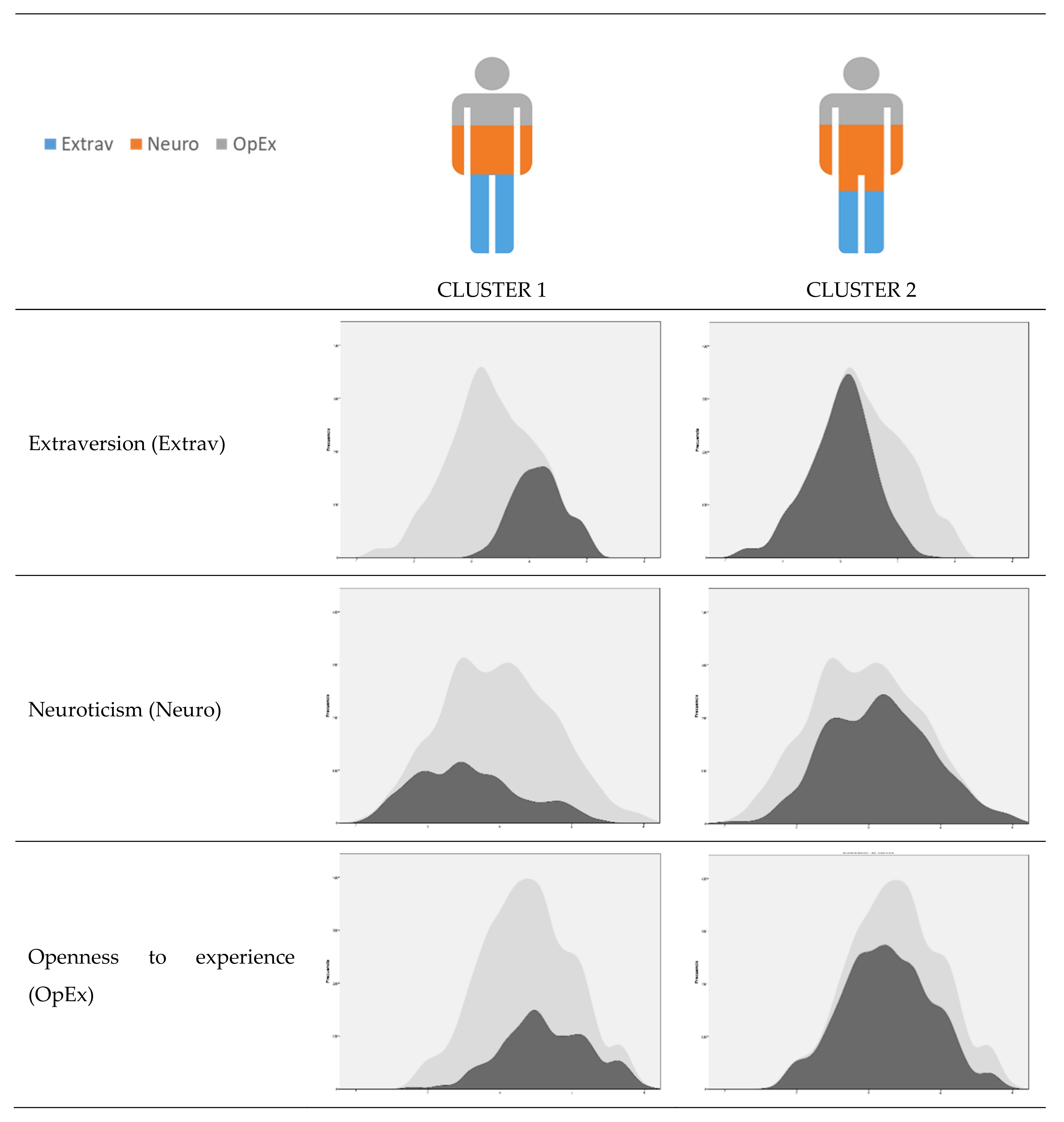

| 1 | 2 | 3 | 4 | 5 | 6 | 7 | 8 | 9 | 10 | |
|---|---|---|---|---|---|---|---|---|---|---|
| 1. Self-expressive creativity | ̶ | |||||||||
| 2. Emotional attention | 0.18*** | ̶ | ||||||||
| 3. Emotional clarity | 0.03 | 0.18*** | ̶ | |||||||
| 4. Emotional repair | 0.03 | 0.13** | 0.38*** | ̶ | ||||||
| 5. Self-esteem | 0.02 | −0.05 | 0.31*** | 0.33*** | ̶ | |||||
| 6. Extraversion | 0.18*** | 0.08* | 0.28*** | 0.26*** | 0.31*** | ̶ | ||||
| 7. Agreeableness | −0.02 | 0.04 | 0.20*** | 0.33*** | 0.22*** | 0.16*** | ̶ | |||
| 8. Conscientiousness | 0.02 | 0.06 | 0.16*** | 0.26*** | 0.22*** | 0.11** | 0.28*** | ̶ | ||
| 9. Neuroticism | 0.12** | 0.30*** | −0.30*** | −0.36*** | −0.34*** | −0.12** | −0.35*** | −0.18*** | ̶ | |
| 10. Openness to experience | 0.24*** | 0.15*** | 0.11** | 0.20*** | 0.06 | 0.14*** | 0.08* | 0.15*** | −0.01 | ̶ |
| Mean | 2.08 | 25.69 | 24.40 | 25.96 | 30.49 | 3.35 | 3.64 | 3.24 | 2.96 | 3.37 |
| SD | 0.66 | 7.66 | 7.32 | 7.41 | 6.42 | 0.76 | 0.56 | 0.70 | 0.75 | 0.63 |
| Model 1 (M1): PERS → SE → SE-C | B | SE | t | 95% CI | |
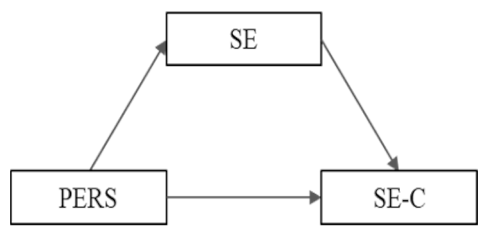 | PERS → SE | −4.068 *** | 0.559 | −7.269 | (−5.167, −2.969) |
| SE → SE-C | −0.003 | 0.004 | −0.734 | (−0.011, 0.005) | |
| Total effect PERS → SE-C | −0.236 *** | 0.057 | −4.083 | (−0.350, −0.122) | |
| Direct effect PERS → SE-C | −0.249 *** | 0.060 | −4.117 | (−0.368, −0.130) | |
| Indirect effect PERS → SE-C | 0.013 | 0.019 | (−0.025, 0.051) | ||
| Model 2 (M2): PERS → EM-ATT → SE-C | B | SE | t | 95% CI | |
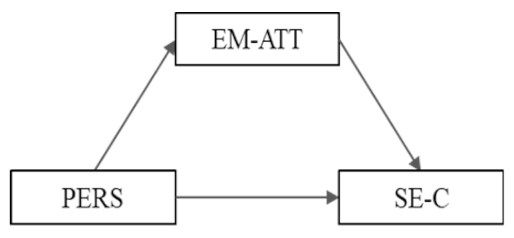 | PERS → EM-ATT | 0.415 | 0.678 | 0.612 | (−0.917, 1.748) |
| EM-ATT → SE-C | 0.016 *** | 0.003 | 4.914 | (0.009, 0.023) | |
| Total effect PERS → SE-C | −0.213 *** | 0.056 | −3.812 | (−0.324, −0.103) | |
| Direct effect PERS → SE-C | −0.220 *** | 0.055 | −4.010 | (−0.328, −0.112) | |
| Indirect effect PERS → SE-C | 0.006 | 0.011 | (−0.013, 0.031) | ||
| Model 3 (M3): PERS → EM-CLA → SE-C | B | SE | t | 95% CI | |
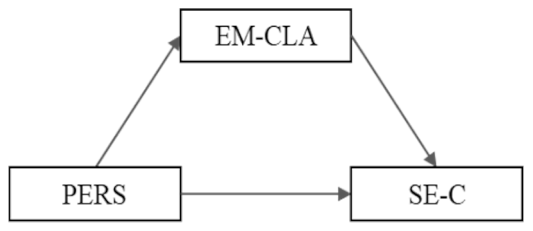 | PERS → EM-CLA | −4.667 *** | 0.629 | −7.416 | (−5.903, −3.431) |
| EM-CLA → SE-C | −0.000 | 0.003 | −0.082 | (−0.007, 0.007) | |
| Total effect PERS → SE-C | −0.189 ** | 0.057 | −3.300 | (−0.301, −0.076) | |
| Direct effect PERS → SE-C | −0.190 ** | 0.060 | −3.174 | (−0.308, −0.072) | |
| Indirect effect PERS → SE-C | 0.001 | 0.018 | (−0.034, 0.038) | ||
| Model 4 (M4): PERS → EM-REP → SE-C | B | SE | t | 95% CI | |
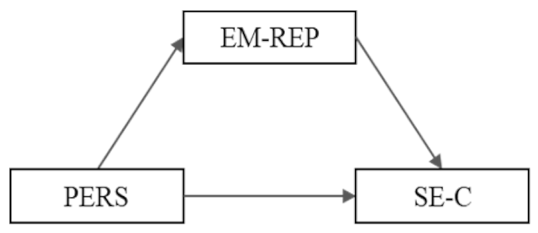 | PERS → EM-REP | −4.650 *** | 0.624 | −7.441 | (−5.877, −3.422) |
| EM-REP → SE-C | −0.000 | 0.003 | −0.216 | (−0.008, 0.006) | |
| Total effect PERS → SE-C | −0.217 *** | 0.057 | −3.767 | (−0.330, −0.103) | |
| Direct effect PERS → SE-C | −0.220 *** | 0.060 | −3.661 | (−0.339, −0.102) | |
| Indirect effect PERS → SE-C | 0.003 | 0.017 | (−0.031, 0.037) | ||
| Model 5 (M5): PERS → SE → EM-ATT → SE-C | B | SE | t | 95% CI | |
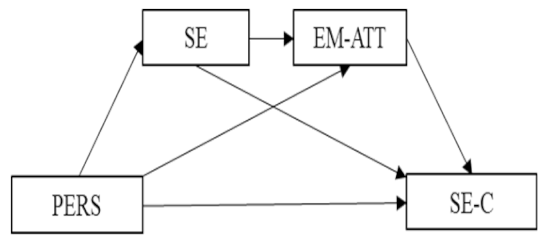 | Total effect PERS → SE-C | −0.236 *** | 0.058 | −4.055 | (−0.350, −0.121) |
| Direct effect PERS → SE-C | −0.250 *** | 0.060 | −4.168 | (−0.358, −0.132) | |
| Ind 1: PERS → SE → SE-C | 0.011 | 0.020 | (−0.027, 0.053) | ||
| Ind 2: PERS → SE → EM-ATT → SE-C | 0.006 | 0.020 | (0.000, 0.018) | ||
| Ind 3: PERS → EM-ATT → SEC-C | −0.003 | 0.004 | (−0.028, 0.016) | ||
© 2019 by the authors. Licensee MDPI, Basel, Switzerland. This article is an open access article distributed under the terms and conditions of the Creative Commons Attribution (CC BY) license (http://creativecommons.org/licenses/by/4.0/).
Share and Cite
Pérez-Fuentes, M.d.C.; Molero Jurado, M.d.M.; Gázquez Linares, J.J.; Oropesa Ruiz, N.F.; Simón Márquez, M.d.M.; Saracostti, M. Self-Expressive Creativity in the Adolescent Digital Domain: Personality, Self-Esteem, and Emotions. Int. J. Environ. Res. Public Health 2019, 16, 4527. https://doi.org/10.3390/ijerph16224527
Pérez-Fuentes MdC, Molero Jurado MdM, Gázquez Linares JJ, Oropesa Ruiz NF, Simón Márquez MdM, Saracostti M. Self-Expressive Creativity in the Adolescent Digital Domain: Personality, Self-Esteem, and Emotions. International Journal of Environmental Research and Public Health. 2019; 16(22):4527. https://doi.org/10.3390/ijerph16224527
Chicago/Turabian StylePérez-Fuentes, María del Carmen, María del Mar Molero Jurado, José Jesús Gázquez Linares, Nieves Fátima Oropesa Ruiz, María del Mar Simón Márquez, and Mahia Saracostti. 2019. "Self-Expressive Creativity in the Adolescent Digital Domain: Personality, Self-Esteem, and Emotions" International Journal of Environmental Research and Public Health 16, no. 22: 4527. https://doi.org/10.3390/ijerph16224527
APA StylePérez-Fuentes, M. d. C., Molero Jurado, M. d. M., Gázquez Linares, J. J., Oropesa Ruiz, N. F., Simón Márquez, M. d. M., & Saracostti, M. (2019). Self-Expressive Creativity in the Adolescent Digital Domain: Personality, Self-Esteem, and Emotions. International Journal of Environmental Research and Public Health, 16(22), 4527. https://doi.org/10.3390/ijerph16224527









